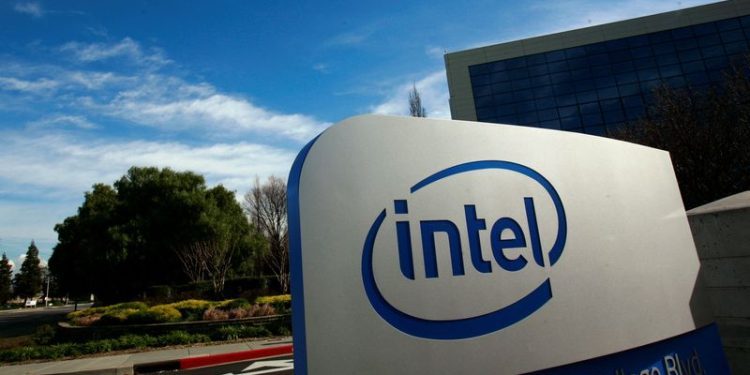By Max A. Cherney
SAN FRANCISCO (Reuters) – Intel (NASDAQ:INTC) lost out on a contract to design and fabricate Sony’s PlayStation 6 chip in 2022, which dealt a significant blow to its effort to build its fledgling contract manufacturing business, according to three sources with knowledge of the events.
The effort by Intel to win out over Advanced Micro Devices (NASDAQ:AMD) in a competitive bidding process to supply the design for the forthcoming PlayStation 6 chip and Taiwan Semiconductor Manufacturing Co as the contract manufacturer would have amounted to billions of dollars of revenue and fabricating thousands of silicon wafers a month, two sources said.
Intel and AMD were the final two contenders in the bidding process for the contract.
Winning the Sony (NYSE:SONY) PlayStation 6 chip design business would have been a victory for Intel’s design segment and would have doubled as a win for the company’s contract manufacturing effort, or foundry business, which was the centerpiece of Intel CEO Pat Gelsinger’s turnaround plan.
Gelsinger announced plans for Intel to create a foundry unit in 2021 and formally launched it at an event in San Jose, California, in February of this year. The PlayStation chip deal originated in Intel’s design segment, but would have been a boon to the financial performance of the foundry business after this year’s separation.
Details of the discussions and how Intel missed out on the contract for Sony’s as-yet-unannounced next-generation game console are reported here for the first time.
Typically, Sony consoles sell more than 100 million units across a half decade. For a chip designer, the console business delivers a lower profit than the gross margins of more than 50% for products like artificial intelligence chips, but nonetheless represents steady business that can profit from technology a company has already developed. Sony’s business also could have helped boost Intel’s contract manufacturing business, which now struggles to find big new clients.
A dispute over how much profit Intel stood to take from each chip sold to the Japanese electronics giant blocked Intel from settling on the price with Sony, according to two of the sources. Instead, rival AMD landed the contract through a competitive bidding process that eliminated others such as Broadcom (NASDAQ:AVGO), until only Intel and AMD remained.
Discussions between Sony and Intel took months in 2022, and included meetings between the two companies’ CEOs, dozens of engineers and executives.
In response to Reuters reporting about the PlayStation 6 talks and Intel’s failure to win the business, an Intel spokesperson said: “We strongly disagree with this characterization but are not going to comment about any current or potential customer conversations. We have a very healthy customer pipeline across both our product and foundry business, and we are squarely focused on innovating to meet their needs.”
Sony and Broadcom did not respond to requests for comment. AMD declined to comment.
BACKWARDS COMPATIBILITY
The current generation of Sony’s PlayStation consoles are powered by custom chips with a design contract fulfilled by AMD.
Sony announced the PlayStation 5 Pro last week, but has not yet unveiled the next generation. Years after its 2020 launch, Sony said it sold 20.8 million of the first-generation PlayStation 5 systems in fiscal 2023.
Similar to how big tech companies like Google (NASDAQ:GOOGL) and Amazon (NASDAQ:AMZN) rely on outside vendors to help design and manufacture custom AI chips, Sony relies on experienced design contractors to make the processors for systems.
Console chip designs typically try to ensure compatibility with earlier versions of the system, to allow users to run older games on the new hardware. Moving from AMD, which made the PlayStation 5 chip, to Intel would have risked backwards compatibility, which was a subject of discussion between Intel and Sony engineers and executives, the sources said.
Ensuring backward compatibility with prior versions of the PlayStation would have been costly and taken engineering resources. Allowing PlayStation users to play games they have purchased for older systems is a feature Sony often includes in a next-generation system.
Having missed the first wave of the AI boom dominated by Nvidia and AMD, Intel reported a disastrous second quarter in August. Intel announced plans to cut 15% of its workforce to save $10 billion and has prepared a plan to reduce its capital spending on factory expansion that was a cornerstone to its foundry strategy.
SEEKING A MARQUEE CUSTOMER
The sudden departure of Lip-Bu Tan, a high-profile board member, over differences in Intel’s future, added to the company’s challenges as Gelsinger and other Intel executives presented plans to the board at a meeting last week, multiple sources said. Reuters reported early this month on the planned board meeting, citing a source familiar with the board discussions.
The potential plans include ideas on how to shave off businesses Intel can no longer afford to operate, Reuters reported. Executives are also expected to debate the future of Intel’s programmable chip unit Altera, including a potential sale, and its manufacturing expansion in Germany.
Intel split its design and manufacturing operations under Gelsinger’s tenure, and has reported financial results separately since the first calendar quarter this year. In April, the company disclosed $7 billion in operating losses for the manufacturing businesses.
Intel has struggled to find a marquee customer it can publicly talk about for the first manufacturing process, known as 18A, open to other companies. If Intel had won the PlayStation 6 chip, it could have occupied its foundry unit for more than five years, two of the sources said.
Sony’s console business could have pumped roughly $30 billion into Intel over the course of the contract, according to Intel’s internal projections, two of the sources said. The PlayStation 2 sold roughly 150 million units since its launch in 2000.
A long-term Sony contract would have helped bring in big new clients for Intel’s contract manufacturing effort, two sources said, as Intel continues to struggle with attracting customers to its advanced 18A process.





